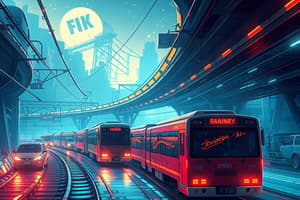Podcast
Questions and Answers
Which of the following modes of transportation is most likely to be used for transporting large amounts of cargo over long distances?
Which of the following modes of transportation is most likely to be used for transporting large amounts of cargo over long distances?
What is the primary function of a seaport?
What is the primary function of a seaport?
Which of the following is an example of a public transportation system?
Which of the following is an example of a public transportation system?
What is the primary purpose of a runway in an airport?
What is the primary purpose of a runway in an airport?
Signup and view all the answers
Which of the following is an example of a safety feature in vehicles?
Which of the following is an example of a safety feature in vehicles?
Signup and view all the answers
What is the primary function of a highway?
What is the primary function of a highway?
Signup and view all the answers
Which of the following is an example of a private transportation system?
Which of the following is an example of a private transportation system?
Signup and view all the answers
What is the primary purpose of traffic cameras in transportation systems?
What is the primary purpose of traffic cameras in transportation systems?
Signup and view all the answers
Study Notes
Modes of Transportation
-
Land Transportation:
- Road transportation: cars, buses, trucks, motorcycles
- Rail transportation: trains, subways, light rail
-
Water Transportation:
- Shipping: cargo ships, tankers, cruise ships
- Boating: sailboats, speedboats, ferries
-
Air Transportation:
- Commercial aviation: airplanes, helicopters
- General aviation: private planes, gliders
Transportation Infrastructure
-
Roads:
- Highways: controlled-access roads for high-speed traffic
- Local roads: streets, avenues, and boulevards for local traffic
-
Railways:
- Tracks: rail lines for trains and subways
- Stations: terminals for passengers and cargo
-
Airports:
- Runways: landing strips for airplanes
- Terminals: buildings for passengers and cargo
-
Seaports:
- Docks: facilities for loading and unloading cargo
- Terminals: buildings for passengers and cargo
Transportation Systems
-
Public Transportation:
- Buses: fixed-route buses, shuttle buses
- Trains: commuter trains, subways
- Ferries: passenger boats
-
Private Transportation:
- Cars: personal vehicles
- Taxis: hired cars for individual transportation
- Ride-hailing: services like Uber and Lyft
-
Freight Transportation:
- Trucks: semi-trailers, delivery vans
- Trains: freight trains, cargo ships
- Air cargo: planes for transporting goods
Transportation Technology
-
Navigation:
- GPS: global positioning system
- Maps: digital and physical maps for navigation
-
Communication:
- Radios: communication systems for vehicles
- Telecommunications: systems for transmitting information
-
Safety Features:
- Airbags: safety devices in vehicles
- Anti-lock braking systems (ABS): safety features in vehicles
- Traffic cameras: surveillance systems for monitoring traffic
Modes of Transportation
- Land transportation includes road transportation (cars, buses, trucks, motorcycles) and rail transportation (trains, subways, light rail)
- Water transportation includes shipping (cargo ships, tankers, cruise ships) and boating (sailboats, speedboats, ferries)
- Air transportation includes commercial aviation (airplanes, helicopters) and general aviation (private planes, gliders)
Transportation Infrastructure
- Highways are controlled-access roads for high-speed traffic
- Local roads consist of streets, avenues, and boulevards for local traffic
- Railways consist of tracks (rail lines for trains and subways) and stations (terminals for passengers and cargo)
- Airports have runways (landing strips for airplanes) and terminals (buildings for passengers and cargo)
- Seaports consist of docks (facilities for loading and unloading cargo) and terminals (buildings for passengers and cargo)
Transportation Systems
- Public transportation includes buses (fixed-route buses, shuttle buses), trains (commuter trains, subways), and ferries (passenger boats)
- Private transportation includes cars (personal vehicles), taxis (hired cars for individual transportation), and ride-hailing (services like Uber and Lyft)
- Freight transportation includes trucks (semi-trailers, delivery vans), trains (freight trains, cargo ships), and air cargo (planes for transporting goods)
Transportation Technology
- Navigation systems include GPS (global positioning system) and maps (digital and physical maps for navigation)
- Communication systems include radios (communication systems for vehicles) and telecommunications (systems for transmitting information)
- Safety features include airbags (safety devices in vehicles), anti-lock braking systems (ABS) (safety features in vehicles), and traffic cameras (surveillance systems for monitoring traffic)
Studying That Suits You
Use AI to generate personalized quizzes and flashcards to suit your learning preferences.
Description
Explore the different modes of transportation, including land, water, and air transportation, as well as the infrastructure that supports them.




